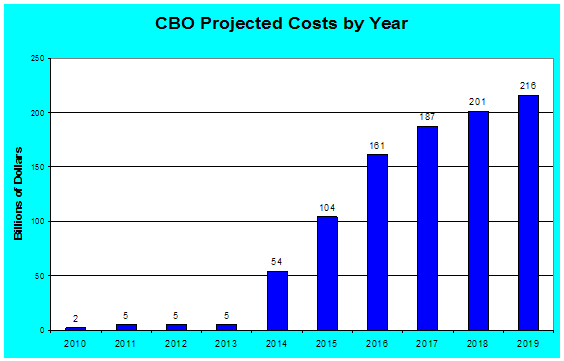Let the cost-shifting begin!
Health care ‘reform’ bill is all about concealing costs
- Tuesday, March 23, 2010
The mammoth, 2,400-page "Patient Protection and Affordable Care Act" that passed the U.S. House of Representatives this weekend on a 219-212 vote will do little to offer medical protection to patients or provide them with affordable care.
One thing the bill does well is to hide a majority of the costs it will impose. No doubt, the Obama administration will tout itself for accomplishing a feat of historic proportions. And truly, it has — the administration that campaigned on "transparency" has ushered through Congress one of the most fiscally opaque and deceptive bills in history.
The latest official scoring of the bill by the non-partisan Congressional Budget Office estimates its total cost over the 2010-2019 period at $940 billion. While this sounds large, the real cost will dwarf the official estimate. Congressional leadership, well aware of the constraints it has written into law requiring the CBO to take congressional fictions at face value, used those constraints to engineer this "low" estimate from the CBO and thereby defraud the public.
The most obvious method of distorting the CBO's reporting of estimated costs was to backload most of the program's huge expenditures. The CBO is prohibited by law from producing an estimate beyond a 10-year time horizon, so that's when most of the huge costs start kicking in. Under the legislation, health care insurance benefits do not even begin until fiscal year 2014, initially phasing in gradually and then escalating dramatically.

Hence, while the CBO's cost estimate for the 2010-2019 period is $940 billion, the bill's cost for the first 10 years of operation could be as high as $3.5 trillion. Of course, this number only represents federal expenditures. It does not include the trillions of dollars in additional costs that will be off-loaded to state governments and private industry — or eventually experienced by Americans denied medical services as the U.S. system comes to approximate that of England or Canada.
The bill initially expands coverage two ways: First, it provides federal subsidies for individuals and families with income up to 400 percent of the federal poverty line ($88,000 for a family of four) so they can purchase government-approved insurance plans on the newly created American Health Benefits Exchanges. Second, it expands Medicaid eligibility to 133 percent of the federal poverty line and requires all Medicaid-eligible individuals to enroll in the program. The CBO estimates that this will add 16 million people to Medicaid rolls by 2019.
Congress is using Medicaid to expand health-insurance coverage so that the federal government can off-load much of the bill's costs onto state governments. Under this provision, Nevada would face the largest proportional financial burden of any state, with its number of Medicaid-eligible individuals swelling by 82.1 percent. The additional cost of this unfunded federal mandate could well mean fewer state tax dollars available for schools, roads and police.
The CBO scoring also includes the highly unlikely scenario that Congress will allow physician reimbursements for Medicare expenses to decline by 23 percent. In fact, congressional leadership intentionally put off the so-called "doc fix" bill that would avoid that adjustment until after passage of the "reform" bill — so as to low-ball the CBO's cost estimate.
A more honest estimate for the "reform" bill's costs — including those imposed through new mandates on private industry — would be closer to the $6 trillion range over the first 10 years of operation. Even then, one would also have to acknowledge that federal entitlement programs routinely outstrip their cost estimates. When Medicare Part A was passed in 1965, for example, it was estimated to cost $9 billion by 1990. It ran slightly over projections, coming in at $67 billion.
Congress' feeble attempt at financing this plan includes a gutting of Medicare — to the tune of $500 billion — including elimination of the highly popular Medicare Advantage program. To be sure, Medicare is facing its own solvency crisis, but the reduction in benefits included in the "reform" bill does not address this. The bill simply shifts spending toward a new entitlement program.
Perhaps what is most tragic about this so-called "reform" bill is that it retreats in precisely the opposite direction from true reform of the health care industry. A price-based system that put health care decisions in the hands of patients, rather than bureaucrats, was required. Instead, Congress delivered a bill that will only exacerbate the current problems, which stem from a lack of consumer accountability. By the CBO's own accounting, the bill will cause insurance premiums for those in the individual market to rise 10 to 13 percent faster than would otherwise be the case.
So for a mere $6 trillion every 10 years, Congress has given us a health care system that is even more highly-bureaucratized and less responsive to patients' needs. Premiums will rise even faster. Shortages will result as more and more doctors leave the profession. And the CBO says there will still be 23 million uninsured.
What a deal.
Geoffrey Lawrence is a fiscal policy analyst at the Nevada Policy Research Institute.





